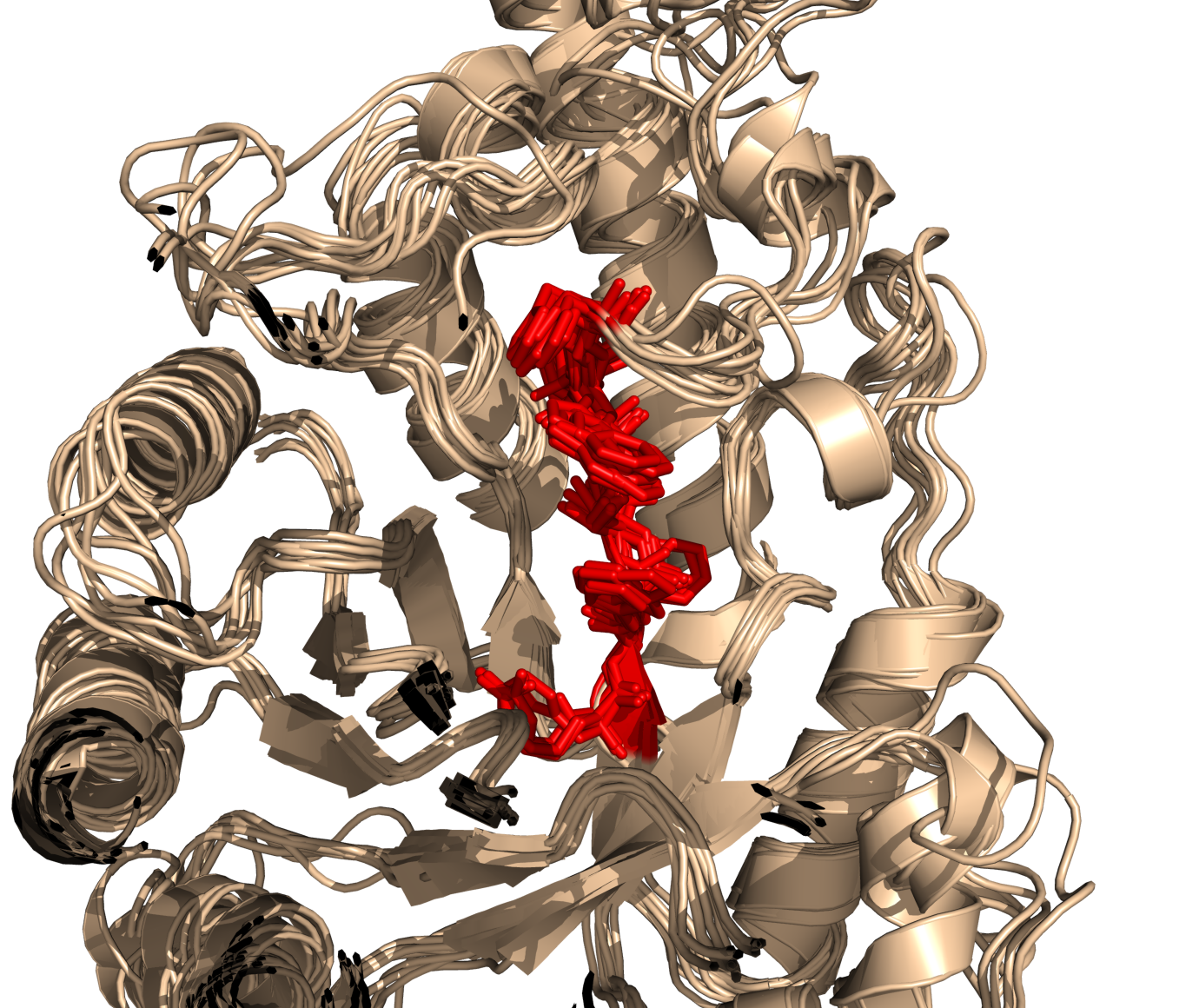Findseq: Difference between revisions
Jump to navigation
Jump to search
m (→The Code) |
Hongbo zhu (talk | contribs) m (add reference to Psico function select_pepseq) |
||
| (6 intermediate revisions by one other user not shown) | |||
| Line 1: | Line 1: | ||
{{Infobox script-repo | |||
|type = script | |||
|filename = findseq.py | |||
|author = [[User:Inchoate|Jason Vertrees]] | |||
|license = BSD | |||
}} | |||
= Overview & Motivation = | = Overview & Motivation = | ||
Anyone ever give you a protein and then say, find the sequence "FLVEW"? Well, this script will find any string or regular expression in a given object and return that selection for you. Here's an example, | Anyone ever give you a protein and then say, find the sequence "FLVEW"? Well, this script will find any string or regular expression in a given object and return that selection for you. Here's an example, | ||
< | <syntaxhighlight lang="python"> | ||
reinitialize | |||
import findseq | |||
# fetch two sugar-binding PDB | # fetch two sugar-binding PDB | ||
fetch 1tvn | fetch 1tvn, async=0 | ||
# Now, find FATEW in 1tvn, similarly | # Now, find FATEW in 1tvn, similarly | ||
findseq FATEW, 1tvn | |||
# lower-case works, too | # lower-case works, too | ||
findseq fatew, 1tvn | |||
# how about a regular expression? | # how about a regular expression? | ||
findseq F.*W, 1tvn | |||
# Find the regular expression: | # Find the regular expression: | ||
# ..H[TA]LVWH | # ..H[TA]LVWH | ||
# in the few proteins loaded. | # in the few proteins loaded. | ||
# I then showed them as sticks and colored them to highlight matched AAs | # I then showed them as sticks and colored them to highlight matched AAs | ||
for x in cmd.get_names(): | for x in cmd.get_names(): findseq.findseq("..H[TA]LVWH", x, "sele_"+x, firstOnly=1) | ||
</ | </syntaxhighlight> | ||
[[Image:SeqFinder.png|center|thumb|400px|Red residues were those matching the regular expression '..H[TA]LVWH'.]] | [[Image:SeqFinder.png|center|thumb|400px|Red residues were those matching the regular expression '..H[TA]LVWH'.]] | ||
| Line 22: | Line 31: | ||
= Usage = | = Usage = | ||
I built this to be rather flexible. You call it as: | I built this to be rather flexible. You call it as: | ||
<source lang="python"> | <source lang="python">findseq needle, haystack[, selName[, het[, firstOnly ]]]</source> where the options are: | ||
:: '''needle''' the sequence of amino acids to find. Should be a string of one letter amino acid abbreviations. Can also be a string-style regular expression (eg. FW.*QQ). | :: '''needle''' the sequence of amino acids to find. Should be a string of one letter amino acid abbreviations. Can also be a string-style regular expression (eg. FW.*QQ). | ||
:: '''haystack''' the PyMOL object or selection in which to search | :: '''haystack''' the PyMOL object or selection in which to search | ||
| Line 29: | Line 38: | ||
:: '''firstOnly''' 0/1 -- if 0 then all matches are selected and returned; if 1 then only the first is returned | :: '''firstOnly''' 0/1 -- if 0 then all matches are selected and returned; if 1 then only the first is returned | ||
= | = See Also = | ||
select_pepseq@[[Psico]] | |||
[[Category:Script_Library]] | [[Category:Script_Library]] | ||
[[Category:ObjSel_Scripts]] | [[Category:ObjSel_Scripts]] | ||
[[Category:Pymol-script-repo]] | |||
Latest revision as of 11:19, 3 January 2013
| Type | Python Script |
|---|---|
| Download | findseq.py |
| Author(s) | Jason Vertrees |
| License | BSD |
| This code has been put under version control in the project Pymol-script-repo | |
Overview & Motivation
Anyone ever give you a protein and then say, find the sequence "FLVEW"? Well, this script will find any string or regular expression in a given object and return that selection for you. Here's an example,
reinitialize
import findseq
# fetch two sugar-binding PDB
fetch 1tvn, async=0
# Now, find FATEW in 1tvn, similarly
findseq FATEW, 1tvn
# lower-case works, too
findseq fatew, 1tvn
# how about a regular expression?
findseq F.*W, 1tvn
# Find the regular expression:
# ..H[TA]LVWH
# in the few proteins loaded.
# I then showed them as sticks and colored them to highlight matched AAs
for x in cmd.get_names(): findseq.findseq("..H[TA]LVWH", x, "sele_"+x, firstOnly=1)
Usage
I built this to be rather flexible. You call it as:
findseq needle, haystack[, selName[, het[, firstOnly ]]]
where the options are:
- needle the sequence of amino acids to find. Should be a string of one letter amino acid abbreviations. Can also be a string-style regular expression (eg. FW.*QQ).
- haystack the PyMOL object or selection in which to search
- selName the name of the returned selection. If you leave this blank, it'll be foundSeqXYZ where XYZ is some random integer (eg. foundSeq1435); if you supply sele then the usual PyMOL (sele) is used; and, finally, if it's anything else, then that will be used verbatim. Defaults to foundSeqXYZ so as not to overwrite any selections you might have in sele.
- het 0/1 -- if 0 then heteroatoms are not considered; if 1 then they are; defaults to 0
- firstOnly 0/1 -- if 0 then all matches are selected and returned; if 1 then only the first is returned
See Also
select_pepseq@Psico
